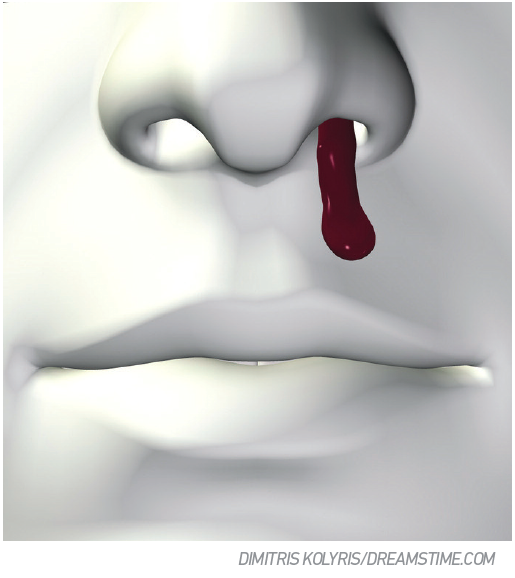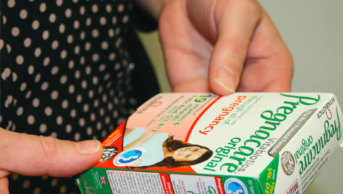
This content was published in 2013. We do not recommend that you take any clinical decisions based on this information without first ensuring you have checked the latest guidance.
A. Bleeding from the nose (epistaxis) is a common condition and rarely serious. Most bleeds are minor and self-limiting. It is thought that approximately 60 per cent of the population will suffer from a nosebleed at some point in their lifetime.1
One large study found that around 6 per cent of people suffering nose bleeds sought medical treatment and that only 1.6 in 10,000 required hospital treatment.2 Despite these reassuring statistics it should be remembered that some nosebleeds can be serious and even fatal if not treated effectively.
Epistaxis has a bimodal distribution in the population, with peaks below the age of 10 years and after the age of 50 years.1 The site of origin of bleeding tends to differ with age. In the young most bleeds occur from Kiesselbach’s plexus in Little’s area, a highly vascular area on the anterior septum where several small vessels anastomose, and which is easily accessible to picking fingers. As patients get older the site of bleeding tends to move back and can involve larger blood vessels.
Causes and risks
Epistaxis is more common in winter months, and this has been attributed to the increased incidence of upper respiratory tract infections and the use of central heating causing drying and irritation of the mucous membranes.3 Under the age of 49 years nosebleeds are more common in males than females — it has been hypothesised that oestrogen may be protective.4
The main causes of epistaxis are trauma to the nose, disorders of platelet function, disorders such as hereditary haemorrhagic telangiectasia, cocaine use, some systemic conditions, such as Wegener’s granulomatosis and tumours (rare).
Very few medicines directly cause epistaxis. Patients using topical nasal steroid sprays may be at greater risk of epistaxis through thinning of the septal mucosa, but these products rarely cause significant bleeds. Epistaxis is listed as a side effect of isotretinoin, probably due to a drying effect on nasal mucosa.
“Blood thinning” or anticoagulant medicines such as aspirin, clopidogrel and warfarin do not cause nosebleeds themselves but, by reducing the blood’s ability to clot, can prolong bleeds, making them heavier and more clinically significant. Patients with epistaxis who take warfarin should have their international normalised ratio checked.
If INR is within their target range patients can usually continue to take warfarin. If the INR is elevated then withholding, or even reversing warfarin could be indicated. The effect of aspirin is not reversible and lasts for the lifetime of a platelet (nine or 10 days), therefore stopping aspirin during a nosebleed is of little benefit. Generally patients should not stop taking any prescribed medicines without consulting their pharmacist or doctor first.
This patient is worried about his blood pressure. The association between hypertension and epistaxis is probably a myth. Although it is common for patients to be hypertensive when they present with nosebleeds this has been attributed to stress, anxiety etc. A follow-up study looking at the incidence of undiagnosed hypertension in patients following epistaxis found it to be no higher than would be expected in the general population.5
Key points
- First-aid or home treatment of a nosebleed consists of pinching the fleshy tip of the nose for 10 to 15 minutes while sitting forward, Patients with bleeds that last longer than this should go to an A&E department.
- Nosebleeds are rarely serious but caution is required with patients on anticoagulants.
- Minor recurrent nosebleeds may be treated with cautery or with Naseptin cream.
Treatment
Many cases of epistaxis can be managed at home. Patients should be encouraged to pinch the soft, fleshy tip of their nose (not the nasal bone), to sit forward and spit out any blood that runs into their mouths. The nose should be held for 10 to 15 minutes without releasing it. If the nose continues to bleed after this the patient should go to the nearest accident and emergency department.4
In A&E patients should have their blood pressure and heart rate checked. Any patient who is thought to have suffered a significant bleed should also have a full blood count and clotting profile checked. If simple first aid measures have failed to stop a bleed, cautery should be considered as the next step in management. This involves closing the offending blood vessels with either silver nitrate or an electric current (usually after the application of topical anaesthetic with or without adrenaline).
If cautery fails to stop bleeding, or a bleeding point cannot be accessed with a cauterising device, in some areas a matrix sealant may be available. This is a mixture of collagen-derived particles and topical bovine-derived thrombin that can be used to control acute epistaxis. “Floseal” is a hydrophilic compound that when applied with a syringe conforms well to the nasal mucosa, is well tolerated and has been shown to be effective at stopping epistaxis in a randomised trial.6
If cautery and matrix sealant (where available) have failed then nasal packing may be required. Packing is usually done with balloons or Vaseline packs. Packs are available in different lengths depending on how far back the bleeding point is thought to be. They are inserted along the floor of the nasal cavity before being inflated, applying direct pressure to the bleeding point.7
Packs may be uncomfortable when in place and most patients require regular analgesia. They are usually left for 24 hours before being deflated, if there is no further bleeding they can then be removed. If packs need to be left in situ for longer than 24 hours patients are often started on prophylactic antibiotics to prevent the development of toxic shock syndrome. If packing fails to arrest the bleeding surgical procedures to ligate arteries supplying the nose are sometimes required.
Cautery can also be used in the treatment of minor recurrent epistaxis which, although rarely serious, can be troublesome and affect quality of life. This has approximately a 50 per cent success rate at preventing rebleeding.
The use of Naseptin cream has been found to be as effective as cautery.8 This contains chlorhexidine and neomycin in a peanut oil based formulation but its main mechanism of action is thought to be in moisturising the mucous membranes.
Any patient who has suffered a nosebleed should receive the same advice to avoid the nose bleeding again:
- Do not to blow or pick the nose
- Avoid hot drinks and hot showers because steam inhalation can cause vasodilation and increased blood flow within the nose
- Avoid heavy lifting or straining (which increases blood pressure)
References
- Kucik CJ. Management of epistaxis. American Family Physician 2005; 71(2)
- Kotecha B, Fowler S, Harkness P, Walmsley J, Brown P, Topham J. Management of epistaxis: a national survey. Ann R Coll Surg Engl. 1996;78(5):444
- Nunez DA, McClymont LG, Evans RA. Epistaxis: a study of the relationship with weather. Clin Otolaryngol Allied Sci. 1990; 15(1):49.
- Daniell HW. Estrogen prevention of recurrent epistaxis. Arch Otolaryngol Head Neck Surg 1995; 121:354.
- Fuchs FD, Moreira LB, Pires CP et al; Absence of association between hypertension and epistaxis: a population-based study. Blood Press. 2003; 12(3): 145-8.
- Mathiasen RA, Cruz RM. Prospective, randomized, controlled clinical trial of a novel matrix hemostatic sealant in patients with acute anterior epistaxis. Laryngoscope 2005; 115:899.
- Leong SC, Roe RJ, Karkanevatos A. No frills management of epistaxis. Emerg Med J. 2005;22(7):470-2
- Upile T, et al. A change in UK epistaxis management. Eur Arch Otorhinolaryngol. 2008;265(11):1349-54
- Kubba H, MacAndie C, Botma M, et al. A prospective, single-blind, randomized controlled trial of antiseptic cream for recurrent epistaxis in childhood. Clin Otolaryngol Allied Sci 2001; 26:465.
You might also be interested in…
How to select the right mouthwash

Thalassaemia and iron supplements
